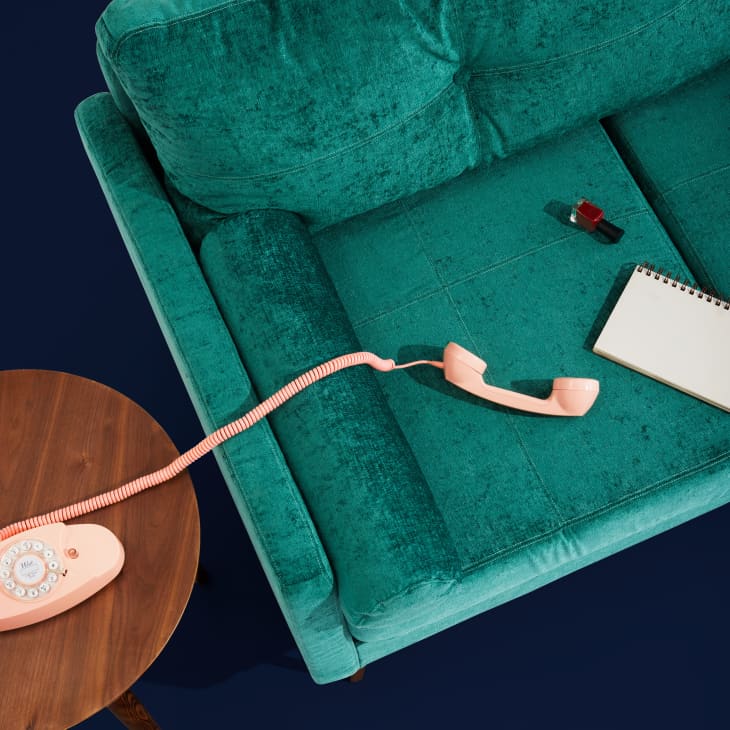Are You Cleaning Your Couches Enough?

Like many young urban dwellers navigating their lives from the headquarters of a modest one-bedroom apartment, my couch serves as a command center. Upon it, I eat my meals, enjoy afternoon naps, recover from the flu, binge watch Netflix (on a good day, maybe even “chill”), and write this article.
On a recent lazy Sunday splayed on my well-worn cushions waiting for my bed sheets to dry, I discovered a soy sauce stain from last week’s takeout and wished I could throw my couch in the wash, too. Vacuum ready, I removed the cushions and encountered a time capsule of the last month (and realistically, beyond). Crumbs, fuzz, coins, pens, and multiple (multiple!) lighters from boyfriends past (a crucial reminder to stop dating smokers).
You wouldn’t dream of leaving your sheets unwashed for weeks at a time, but the sofa never really gets that sort of deep clean. I wondered: Is the occasional vacuum enough, or should we be laundering our sofas more, just like our bed sheets? I called up the experts for their take.
Dr. Philip M. Tierno, Jr., professor of microbiology and pathology at NYU School of Medicine, shared with me a great deal of information that both comforted and terrified me. First, Dr. Tierno brought some much-needed clarity to my conundrum: “It’s less about the bed sheets than the accumulation of what occurs in the core of the mattress over time.” Human beings shed a variety of items from our bodies and from our skin, including insects, insect parts, dust, lint fibers, particles, pollen, soil, sand, chemicals, cosmetics, lotion, and oils, explains Dr. Tierno.
Given this bleak news about the often visually imperceptible hazards that lie waiting inside our mattresses, Dr. Tierno suggests an easy solution: “The ideal situation with regard to bedding is to have an outer protective allergy barrier on the mattress.”
But what about couches? Basically, depending on your use, the couch accumulates the same things. But given the sheer amount of time we spend in our beds and other factors, like the clothes we wear to sleep or the, um, nocturnal activities we conduct, the rate or amount that collects may differ. “If your couch is used as a bed, like a pull out couch, you should have that allergy protector on the mattress of your couch. But as far as the surface is concerned, you have to realize that microbes don’t live forever on the surface,” says Dr. Tierno.
Spot cleaning, vacuuming, good hygiene, and disinfecting sprays go a long way. After vacuuming, use a spray like Lysol over the surface, says Dr. Tierno. This step is particularly important if you’re spending sick days on the couch, he adds.
For those who use their couches conventionally (read: not me), this periodic cleaning is good enough. “Vacuuming once a week would be part of a good hygienic practice,” says Dr. Tierno. For those, like me, who basically thrive on their sofa, the disinfecting stakes are a little higher. In these instances, increase the frequency with which you vacuum and disinfect your sofa with disinfectant spray—and consider putting a bed sheet over the couch for longer naps as well.
If your couch looks dirty, it should be cleaned, but four times a year is a good base line, says Instagram-famous cleaning expert and influencer Becky Rapinchuk, a.k.a. @CleanMama. She recommends a fabric refresher with a little bit of rubbing alcohol, some essential oils, and water. And if your pillows are machine-washable, a spin in the dryer will not only fluff them, but also kill any germs, she says.
Given all of my newly acquired knowledge, my weekend plans include buying an allergy barrier, stocking up on soap and disinfectant sprays, and vacuuming up dust mite-feeding debris. Then I’ll kick my feet up on the couch, schedule a repeating cleaning appointment in my Google Calendar, and enjoy a clean, tidy, and stress-free nap.